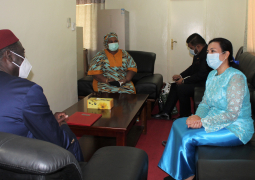In April, Senegalese customs authorities confiscated a significant amount of cocaine near the country's border with Mali. Experts say this is one of many instances highlighting the increasing involvement of the region in the global drug trade.
The West African country now acts as a key stopover between South America and Europe, typically the final destination for the traffickers' goods.
But cocaine consumption in the region is declining to minimal levels, further cementing West Africa's role as a transit point.
Decrease in local consumption
The consumption of cocaine on the streets in Dakar has plummeted in recent decades, making the foreign market far more attractive for those involved in the drug trade.
Andre Correa, an independent consultant in the fight against juvenile delinquency, told DW that "compared to the 1990s, cocaine consumption has decreased a lot, but transit has increased."
A former cocaine user himself, Correa added that in "our time in the 1980s, we consumed it by sniffing and everything. Now they've turned it into pebbles, the young people," referring to the crystal form of the drug that can be smoked, also known as crack.
Crack cocaine offers a more intense effect and is typically more impure and, therefore, cheaper to afford for many drug abusers.
At the height of its popularity, there used to be areas in Dakar, such as Medina, Grand Dakar, and Parcelles Assainies, where crack smoking was a common sight, especially at night.
But today, even this more affordable version of the highly addictive drug is no longer a commonplace sight.
Since 2004, seizures of Europe-bound cocaine in Africa have risen fivefold, according to UNODCImage: AP
Change in regional trafficking patterns
Trafficking activities have replaced local consumption patterns, and Senegal's involvement in cocaine trafficking is just one aspect of a larger trend of extensive trafficking in the sub-region, according to Amado Philip de Andres, the regional representative for West and Central Africa at the United Nations Office on Drugs and Crime (UNODC).
"If we compare seizures between 2019 and 2024, cocaine seizures and trafficking to West Africa are clearly increasing. Guinea Bissau is no longer the main gateway," de Andres told DW, adding that "(w)e have seen seizures in Cape Verde, Senegal, Gambia, Guinea-Bissau, Liberia, Cote d'Ivoire. We have also seen an increase in cocaine trafficking to Togo and Benin."
From 2019 to 2022, Cape Verde alone witnessed the confiscation of over 17 tons of cocaine, highlighting the magnitude of the role the region plays in the global drug trade.
There has also been a significant increase in seizures along the Gulf of Guinea, with more than 10 tons reported to have been confiscated by March 2024.
In Sahel countries like Burkina Faso, Niger, and Mali, there has equally been a noticeable increase in record seizures, suggesting that these nations are now playing a significant part in the smuggling of cocaine to Europe.
Despite these changing trends and patterns, the drug trade also continues to have severe consequences for the local populations.
Mor Gassama, an economist from Senegal, highlights the country's significance as a transit point while still emphasizing the impact on public health and the economy.
"Traffic is extremely dense, and Dakar still remains a transit zone, even if some of it is likely to be consumed on the spot. This is not good news, first of all, for the health of the population, but it will also promote the circulation of illicit money," Gassama said.
In response to this escalating rate of drug trafficking, UNODC has been actively collaborating with member countries to enhance border control measures and try to combat drug trafficking and serious crime in Africa this way, says de Andrés.
But the record volumes of cocaine seizures in the region continue.



